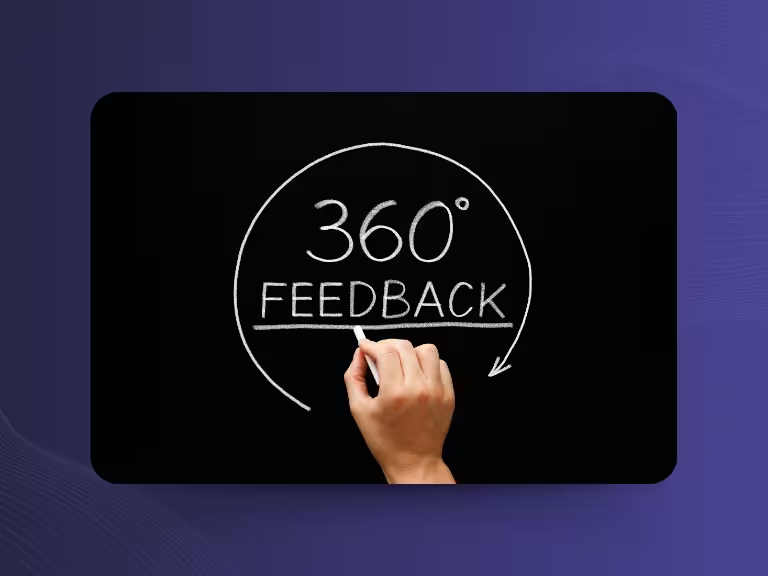Table of Contents
Imagine receiving feedback not just from your boss, but also from your colleagues, your employees, and even from customers. That's 360-degree feedback – a method that paints a complete picture of your work performance and personality on the job.
In modern companies, 360-degree feedback is gaining increasing importance. Why? Because the working world has become more complex. Teams work more interconnected, hierarchies are becoming flatter, and the demands on leaders and employees are continuously rising.
The benefits are clear: transparency creates trust, diverse feedback promotes personal development and improves team dynamics. At the same time, companies receive an objective picture of their employees – far beyond what a single supervisor can assess.
In this article, you'll learn everything important about 360-degree feedback: from the definition to the advantages to practical implementation, challenges, and the use of modern technology.
What is 360-Degree Feedback? — Definition and Process
Basic Principles of 360-Degree Feedback
360-degree feedback is based on a simple but powerful principle: multi-perspective feedback. Instead of only questioning the direct supervisor, you gather feedback from all sides – from colleagues, employees, customers, and yourself.
The goal is a holistic picture of performance, behavior, and development potential. Unlike traditional feedback systems, which are often one-sided and hierarchically influenced, 360-degree feedback creates a comprehensive assessment foundation.
A practical example: While your boss might praise your strategic abilities, your team members might see room for improvement in communication. These different perspectives complement each other and show you where you really stand.
Involved Parties and Their Roles
360-degree feedback involves various groups: peers at the same hierarchical level, supervisors, subordinates, and sometimes external stakeholders like customers or business partners.
This diversity of feedback providers is crucial. Each group experiences you in different situations and roles. While your boss evaluates your projects from a strategic perspective, your employees see how you act as a leader. Colleagues experience your teamwork abilities, customers your service orientation.
Anonymity plays a central role. Only when feedback providers know that their assessments will be treated confidentially do they give honest and constructive feedback.
Process Flow of 360-Degree Feedback
A structured process is key to success. First, you carefully plan the process and transparently communicate the goals to all participants. Then you select suitable feedback providers and appropriate instruments.
Implementation usually occurs digitally – this saves time and ensures anonymity. After the survey comes the evaluation. Here, detailed reports are created that show strengths and development areas.
The most important step comes at the end: developing concrete measures based on the results. Without this step, even the best feedback remains ineffective.
Benefits and Value of 360-Degree Feedback
Personal and Professional Development
360-degree feedback is like a mirror that shows you how others really perceive you. It identifies not only your strengths but also blind spots and improvement potential that you might not be aware of yourself.
These insights promote self-reflection and willingness to learn. When multiple people give similar feedback, the feedback becomes more credible and more effective. This contributes significantly to individual career planning.
An example: A team leader learns through 360-degree feedback that his technical competence is highly valued, but his delegation skills need improvement. With this insight, he can work specifically on his leadership quality.

Improving Team and Organizational Culture
360-degree feedback builds an open feedback culture. Teams learn to interact constructively with each other and build trust. This transparency becomes the basis for fair assessments and equitable decisions.
Collaboration improves because misunderstandings are uncovered and communication problems become visible. Teams that regularly use 360-degree feedback often show higher collaboration and better performance.
Increasing Performance and Motivation
Through multiple feedback sources, a more objective performance assessment emerges. This leads to fairer evaluations and reduces subjectivity. At the same time, you can specifically identify where training and development needs exist.
Studies show that teams with regular 360-degree feedback processes have up to 15% higher employee satisfaction. Motivation increases because employees feel that their development is taken seriously.
Successfully Implementing 360-Degree Feedback — Step-by-Step Guide
Preparing the Feedback Process
Success begins with clear goal definition. What do you want to achieve with 360-degree feedback? Is it about talent development, performance evaluation, or team building? These goals must be communicated transparently.
When selecting feedback providers, you focus on balance. Ideally, you choose 8-12 people from different areas. Digital software solutions like Culture Amp or specialized tools support the entire process.
Data protection and anonymity are non-negotiable. Only when participants can trust that their assessments will be treated confidentially do they give honest feedback.
Implementation and Moderation
Digital data collection has many advantages: it's efficient, scalable, and ensures anonymity. It's important that you plan for emotional reactions and resistance. Not everyone handles criticism equally well.
Training for feedback providers and recipients is often necessary. They learn how constructive feedback is given and received. Here, tools like Sally can be helpful for documenting and following up on important conversations.
Evaluation and Use of Results
Analysis of feedback data is crucial. You look for patterns, strengths, and weaknesses. Modern software can help visualize complex data and make it understandable.
Feedback conversations should contain coaching elements. It's not just about presenting results, but also about creating individual development plans. Sally can record and transcribe these important development conversations so nothing is lost.
Sustainable Integration into Company Culture
360-degree feedback is not a one-time event but a continuous process. Regular feedback cycles – semi-annually or annually – show progress and changes.
Integration into performance management makes feedback a permanent part of talent development. You also promote diversity and inclusion by including diverse feedback sources.

Challenges and Solution Approaches for 360-Degree Feedback
Common Pitfalls
The biggest challenges in 360-degree feedback are subjectivity and political influences. Not all feedback providers are objective – personal conflicts or sympathies can distort assessments.
Fear of criticism is another stumbling block. Many employees fear negative evaluations and react emotionally or defensively. Bureaucratic overhead and lack of professionalism can additionally reduce acceptance.
Strategies for Overcoming
Anonymous data collection and transparent communication are the foundation for successful 360-degree feedback. When all participants know how the process works and how data is used, acceptance increases significantly.
Training and professional moderation improve feedback quality. Feedback providers learn to evaluate constructively, feedback recipients learn to handle criticism. Psychological support through coaching and trustworthy conversation management help break down defense mechanisms.
Technological Support for Greater Efficiency
Modern feedback software automates many processes and makes 360-degree feedback scalable. Tools like SurveyMonkey or Qualtrics offer professional surveys, while Sally supports documentation and follow-up of important feedback conversations.
AI-supported evaluations enable personalized analyses and recommendations. The advantages of digital tools are clear: scalability, data protection, and significant time savings.
Outlook — Trends and Best Practices in 360-Degree Feedback
Future of Feedback: Technology and AI
Artificial intelligence is also revolutionizing 360-degree feedback. AI can create personalized analyses that go far beyond simple averages. Automated recommendations and individual development plans are becoming increasingly precise.
This technology makes it possible to analyze large amounts of data and recognize patterns that humans would overlook. The future of feedback will be data-driven and highly personalized.
360-Degree Feedback as Part of Agile Corporate Culture
In agile organizations, 360-degree feedback becomes part of continuous learning and development cycles. Instead of once annually, feedback occurs more frequently and at shorter intervals.
The connection with diversity and inclusion initiatives makes feedback even more valuable. Different perspectives and cultural backgrounds enrich assessments and promote a more inclusive work culture.
Inspiring Case Studies
Large companies like Google, Microsoft, and SAP successfully use 360-degree feedback as an integral part of their talent development. The key factors of their success are trust, transparency, and systematic employee involvement.
Google, for example, combines 360-degree feedback with continuous development programs and makes it a natural part of work culture. Microsoft uses feedback to promote diversity and develop leadership competencies.
Conclusion — 360-Degree Feedback as an Engine for Development and Collaboration
360-degree feedback is far more than an assessment tool – it's an engine for personal development and better collaboration. The most important success factors are transparency, targeted use of technology, and psychological support.
Modern tools like Sally can help support the entire feedback process – from documenting important conversations to following up on results. Integration into existing systems makes the process more efficient and sustainable.
The key is to view 360-degree feedback not as a one-time event but as a continuous component of corporate culture. Companies that achieve this benefit from more motivated employees, better teams, and ultimately better business results.
The future belongs to data-driven, technology-supported feedback systems that simultaneously place people at the center. If you want to implement 360-degree feedback in your company, start with clear goals, transparent communication, and the right technological support.

Try meeting transcription now!
Experience how effortless meeting notes can be – try Sally free for 4 weeks.
Test NowOr: Arrange a Demo Appointment

.avif)


